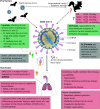The origin, transmission and clinical therapies on coronavirus disease 2019 (COVID-19) outbreak - an update on the status
- PMID: 32169119
- PMCID: PMC7068984
- DOI: 10.1186/s40779-020-00240-0
The origin, transmission and clinical therapies on coronavirus disease 2019 (COVID-19) outbreak - an update on the status
Abstract
An acute respiratory disease, caused by a novel coronavirus (SARS-CoV-2, previously known as 2019-nCoV), the coronavirus disease 2019 (COVID-19) has spread throughout China and received worldwide attention. On 30 January 2020, World Health Organization (WHO) officially declared the COVID-19 epidemic as a public health emergency of international concern. The emergence of SARS-CoV-2, since the severe acute respiratory syndrome coronavirus (SARS-CoV) in 2002 and Middle East respiratory syndrome coronavirus (MERS-CoV) in 2012, marked the third introduction of a highly pathogenic and large-scale epidemic coronavirus into the human population in the twenty-first century. As of 1 March 2020, a total of 87,137 confirmed cases globally, 79,968 confirmed in China and 7169 outside of China, with 2977 deaths (3.4%) had been reported by WHO. Meanwhile, several independent research groups have identified that SARS-CoV-2 belongs to β-coronavirus, with highly identical genome to bat coronavirus, pointing to bat as the natural host. The novel coronavirus uses the same receptor, angiotensin-converting enzyme 2 (ACE2) as that for SARS-CoV, and mainly spreads through the respiratory tract. Importantly, increasingly evidence showed sustained human-to-human transmission, along with many exported cases across the globe. The clinical symptoms of COVID-19 patients include fever, cough, fatigue and a small population of patients appeared gastrointestinal infection symptoms. The elderly and people with underlying diseases are susceptible to infection and prone to serious outcomes, which may be associated with acute respiratory distress syndrome (ARDS) and cytokine storm. Currently, there are few specific antiviral strategies, but several potent candidates of antivirals and repurposed drugs are under urgent investigation. In this review, we summarized the latest research progress of the epidemiology, pathogenesis, and clinical characteristics of COVID-19, and discussed the current treatment and scientific advancements to combat the epidemic novel coronavirus.
Keywords: Clinical characteristics; Coronavirus disease 2019 (COVID-19); Origin; SARS-CoV-2; Therapy; Transmission.
Conflict of interest statement
The funder had no role in study design, data collection, and analysis, decision to publish, or preparation of the manuscript. The authors declare that they have no competing interests.
Figures

References
-
- WHO . Coronavirus disease (COVID-2019) situation reports. 2020.
Publication types
MeSH terms
Substances
LinkOut - more resources
Full Text Sources
Other Literature Sources
Medical
Research Materials
Miscellaneous

